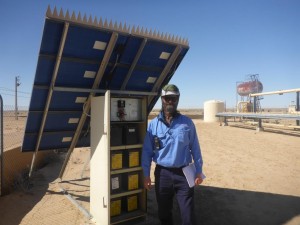Big Data
How Predictive Analytics Helps Santos in Australia’s Outback
February 23, 2016 | Written by: Steve Hamm
Categorized: Big Data | Cognitive Computing | Data Analytics
Share this post:
Santos is one of the largest natural gas and oil producers in the Asia-Pacific. It’s East Australian Business Unit operates more than 1000 wells and associated infrastructure scattered over thousands of square miles in Australia’s Cooper Basin, in Southern Australia.
Faced with summer temperatures that can exceed 45 degrees Celsius, seasonal flooding events and long trips to wells and other facilities on dirt roads in these harsh conditions our field technicians rely on four-wheel-drive vehicles, carry plenty of water and wear protective clothing when they set out for maintenance inspections or to make repairs.
With oil prices at three-year lows, there’s currently plenty of incentive to minimize field maintenance costs. But, for Santos, the difficult natural environment in which we operate means we have to go the extra mile to safeguard both our equipment and our people.
That’s why, with IBM’s help, we are installing a predictive asset monitoring and alert system for our extensive network of pipelines, wells, pumps, solar energy panels, batteries, and other equipment. Our analytics system, Applied Operational Analytics, will help reduce downtime for wells and other assets, lower repair bills and cut down on unnecessary trips in the field.
We have been gathering huge amounts of information from sensors attached to our equipment for years—measuring factors such as temperature, pressure and voltage. But we weren’t using the data in the most efficient manner by relying only on alarms or individual equipment specific alerts or trends
Then, in 2014, one of our staff, David Storey, who analyzed stock market trends in his spare time, suggested that we look for patterns in our combined operations data that might reveal emerging problems or operating inefficiencies.
We had been using IBM predictive modeling technology in another application, so we knew what it’s capable of. We made it a key component of our new Operational Analytics system. The key to developing the system further has been the unprecedented collaboration with IBM and other partners such as Professor Stephen Roberts, head of the Machine Learning Research Group at University Oxford, in the UK, to help us develop weather and temperature models.
As an example of the operational analytics system…
In the field, we use a combination of solar panels and batteries to keep our wells pumping around the clock. Via the monitoring system, we discovered that some of our batteries were running out of juice before sunrise, effecting our production. We were also able to recommend optimizing the set-up of Battery, Solar Panel and control units to optimize them, improving production and saving operational expenses. Now, through monitoring and analysis, we can tell when batteries are starting to fail or if there are any issues with the control systems. The system alerts maintenance teams so they can review priorities and replace the batteries or effect a repair before the problem escalates.
The new system helps out with another issue, as well. To suppress corrosion in our pipelines we automatically inject corrosion inhibitor fluid into the wells when the pumps are operating. In the past, we had to send field technicians to check the levels of fluid in storage tanks. Now, we can monitor them remotely so we know when to refill, and we compare pump activity to fluid levels to detect mismatches that might indicate that the equipment isn’t working optimally.
I don’t get into the field very often, but, last September, I drove out with Steve Lechowicz who leads our analytics development team and a field engineer, Len Bauer, to manually inspect 10 wells in the Cooper Basin that the monitoring system had flagged for trouble. It was correct with all 10. While we were there, the engineer got an alert about a potential problem with another well. We drove over. The problem was exactly as described. He fixed it on the spot.
Now, we’re looking into extending the predictive system to other processes and pieces of equipment across all of our operations, including gas processing plants and drilling operations.
Oil and gas production is a tough business these days—not just the economics, but, in many cases, the operating environment. With these new analytics systems we’re providing essential information and insight on the operating health of key elements of our infrastructure. I’m proud that Santos is pioneering in this area, and expect that we’ll have a lot of company among our industry peers before too long.
Accelerating Digital Transformation with DataOps
Across an array of use cases, AI pioneers are employing a core set of new AI capabilities to unlock the value of data in new ways. According to the 2019 IBM Global C-suite study, leaders are using data 154% more to identify unmet customer needs, enter new markets, and develop new business models. These leaders […]
The 3 Beachheads of AI
(Part 2 in a Series) We have been partnering with and assisting clients on their data needs and strategies for years. It’s clear that data and AI are two-sides of the same coin; in fact, this understanding spawned the AI Ladder concept. We’ve developed skills training in the areas of data science and machine learning; […]
Medicine and the Message: Consumer Engagement and the Power of Nontraditional Data
The journal Health Affairs estimates that the U.S. spends nearly $500 billion annually on pharmaceutical treatments. Focusing on clinical value alone isn’t enough to meet business growth targets — customer experience plays a critical role in long-term brand success. But experience doesn’t occur in isolation: To win trust and boost spending, pharma brands must use […]




